Makita RT0700C User Manual
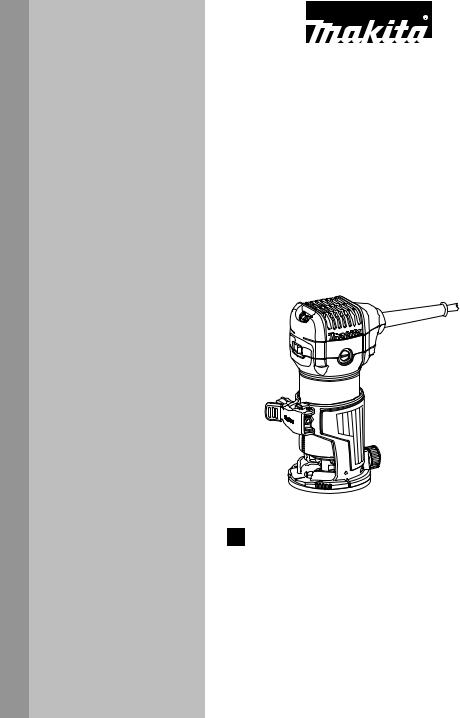
INSTRUCTION MANUAL
MANUEL D'INSTRUCTION
MANUAL DE INSTRUCCIONES
Trimmer
Affleureuse
Recortadora
RT0700C
RT0701C
011833
DOUBLE INSULATION
DOUBLE ISOLATION
DOBLE AISLAMIENTO
IMPORTANT: Read Before Using.
IMPORTANT: Lire avant usage.
IMPORTANTE: Leer antes de usar.

ENGLISH (Original instructions)
SPECIFICATIONS
Model |
RT0700C / RT0701C |
Collet chuck capacity |
1/4", 3/8" |
No load speed (RPM) |
10,000 - 30,000 /min |
Overall length |
200 mm (7-7/8") |
Net weight |
1.8 (3.9 lbs) |
•Due to our continuing program of research and development, the specifications herein are subject to change without notice.
•Specifications may differ from country to country.
•Weight according to EPTA-Procedure 01/2003
GEA008-2
General Power Tool Safety Warnings
 WARNING Read all safety warnings and all instructions. Failure to follow the warnings and instructions may result in electric shock, fire and/or serious injury.
WARNING Read all safety warnings and all instructions. Failure to follow the warnings and instructions may result in electric shock, fire and/or serious injury.
Save all warnings and instructions for future reference.
The term "power tool" in the warnings refers to your mains-operated (corded) power tool or battery-operated (cordless) power tool.
Work area safety
1.Keep work area clean and well lit. Cluttered or dark areas invite accidents.
2.Do not operate power tools in explosive atmospheres, such as in the presence of flammable liquids, gases or dust. Power tools create sparks which may ignite the dust or fumes.
3.Keep children and bystanders away while operating a power tool. Distractions can cause you to lose control.
Electrical Safety
4.Power tool plugs must match the outlet. Never modify the plug in any way. Do not use any adapter plugs with earthed (grounded) power tools. Unmodified plugs and matching outlets will reduce risk of electric shock.
5.Avoid body contact with earthed or grounded surfaces such as pipes, radiators, ranges and refrigerators. There is an increased risk of electric shock if your body is earthed or grounded.
6.Do not expose power tools to rain or wet conditions. Water entering a power tool will increase the risk of electric shock.
7.Do not abuse the cord. Never use the cord for carrying, pulling or unplugging the power tool. Keep cord away from heat, oil, sharp edges or moving parts. Damaged or entangled cords increase the risk of electric shock.
8.When operating a power tool outdoors, use an extension cord suitable for outdoor use. Use of a cord suitable for outdoor use reduces the risk of electric shock.
9.If operating a power tool in a damp location is unavoidable, use a ground fault circuit interrupter (GFCI) protected supply. Use of an GFCI reduces the risk of electric shock.
Personal Safety
10.Stay alert, watch what you are doing and use common sense when operating a power tool. Do not use a power tool while you are tired or under the influence of drugs, alcohol or medication. A moment of inattention while operating power tools may result in serious personal injury.
11.Use personal protective equipment. Always wear eye protection. Protective equipment such as dust mask, non-skid safety shoes, hard hat, or hearing protection used for appropriate conditions will reduce personal injuries.
12.Prevent unintentional starting. Ensure the switch is in the off-position before connecting to power source and/or battery pack, picking up or carrying the tool. . Carrying power tools with your finger on the switch or energising power tools that have the switch on invites accidents.
13.Remove any adjusting key or wrench before turning the power tool on. A wrench or a key left attached to a rotating part of the power tool may result in personal injury.
14.Do not overreach. Keep proper footing and balance at all times. This enables better control of the power tool in unexpected situations.
15.Dress properly. Do not wear loose clothing or jewellery. Keep your hair, clothing, and gloves away from moving parts. Loose clothes, jewellery or long hair can be caught in moving parts.
16.If devices are provided for the connection of dust extraction and collection facilities, ensure these are connected and properly used. Use of dust collection can reduce dust-related hazards.
2
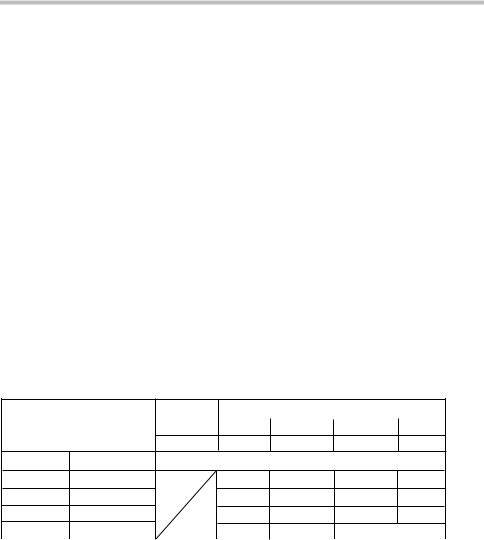
Power tool use and care
17.Do not force the power tool. Use the correct power tool for your application. The correct power tool will do the job better and safer at the rate for which it was designed.
18.Do not use the power tool if the switch does not turn it on and off. Any power tool that cannot be controlled with the switch is dangerous and must be repaired.
maintained cutting tools with sharp cutting edges are less likely to bind and are easier to control.
23.Use the power tool, accessories and tool bits
etc. in accordance with these instructions, taking into account the working conditions and the work to be performed. Use of the power tool for operations different from those intended could result in a hazardous situation.
Service
19.Disconnect the plug from the power source 24. Have your power tool serviced by a qualified
and/or the battery pack from the power tool before making any adjustments, changing accessories, or storing power tools. Such preventive safety measures reduce the risk of starting the power tool accidentally.
20.Store idle power tools out of the reach of children and do not allow persons unfamiliar with the power tool or these instructions to operate the power tool. Power tools are dangerous in the hands of untrained users.
repair person using only identical replacement parts. This will ensure that the safety of the power tool is maintained.
25.Follow instruction for lubricating and changing accessories.
26.Keep handles dry, clean and free from oil and grease.
USE PROPER EXTENSION CORD. Make sure your extension cord is in good condition. When using an extension cord, be sure to use one heavy enough to
21.Maintain power tools. Check for misalignment carry the current your product will draw. An undersized or binding of moving parts, breakage of parts cord will cause a drop in line voltage resulting in loss of and any other condition that may affect the power and overheating. Table 1 shows the correct size
power tool’s operation. If damaged, have the power tool repaired before use. Many accidents are caused by poorly maintained power tools.
22. Keep cutting tools sharp and clean. Properly
to use depending on cord length and nameplate ampere rating. If in doubt, use the next heavier gage. The smaller the gage number, the heavier the cord.
Table 1: Minimum gage for cord
|
Volts |
|
Total length of cord in feet |
|
|
|
|
|
|
|
|
Ampere Rating |
120V |
25 ft. |
50 ft. |
100 ft. |
150 ft. |
|
220V - 240V |
50 ft. |
100 ft. |
200 ft. |
300 ft. |
More Than |
Not More Than |
|
AWG |
|
|
0 |
6 |
18 |
16 |
16 |
14 |
6 |
10 |
18 |
16 |
14 |
12 |
10 |
12 |
16 |
16 |
14 |
12 |
12 |
16 |
14 |
12 |
Not Recommended |
|
000300 |
|
|
|
|
|
GEB019-4
TRIMMER SAFETY WARNINGS
1.Hold power tool by insulated gripping surfaces, because the cutter may contact its own cord.
Cutting a "live" wire may make exposed metal parts of the power tool "live" and shock the operator.
2.Use clamps or another practical way to secure and support the workpiece to a stable platform.Holding the work by your hand or against the body leaves it unstable and may lead to loss of control.
3.Wear hearing protection during extended period of operation.
4.Handle the bits very carefully.
5.Check the bit carefully for cracks or damage before operation. Replace cracked or damaged bit immediately.
6.Avoid cutting nails. Inspect for and remove all nails from the workpiece before operation.
7.Hold the tool firmly.
8.Keep hands away from rotating parts.
9.Make sure the bit is not contacting the workpiece before the switch is turned on.
3
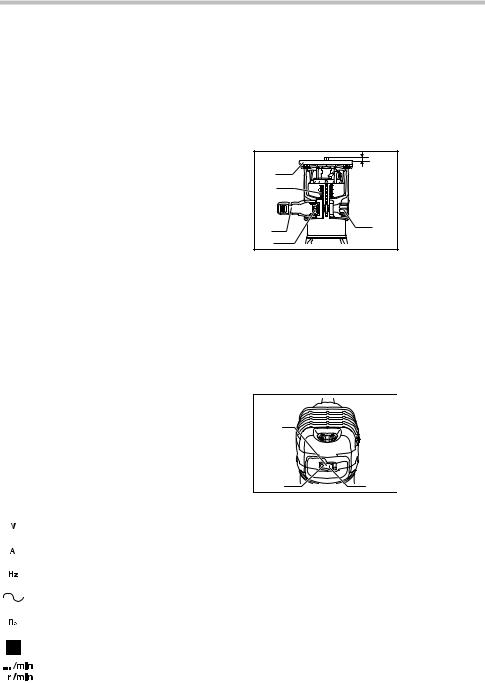
10.Before using the tool on an actual workpiece, let it run for a while. Watch for vibration or wobbling that could indicate improperly installed bit.
11.Be careful of the bit rotating direction and the feed direction.
12.Do not leave the tool running. Operate the tool only when hand-held.
13.Always switch off and wait for the bit to come to a complete stop before removing the tool from workpiece.
14.Do not touch the bit immediately after operation; it may be extremely hot and could burn your skin.
15.Do not smear the tool base carelessly with thinner, gasoline, oil or the like. They may cause cracks in the tool base.
16.Use bits of the correct shank diameter suitable for the speed of the tool.
17.Some material contains chemicals which may be toxic. Take caution to prevent dust inhalation and skin contact. Follow material supplier safety data.
18.Always use the correct dust mask/respirator for the material and application you are working with.
SAVE THESE INSTRUCTIONS.
 WARNING:
WARNING:
DO NOT let comfort or familiarity with product (gained from repeated use) replace strict adherence to safety rules for the subject product. MISUSE or failure to follow the safety rules stated in this instruction manual may cause serious personal injury.
USD201-2
Symbols
The followings show the symbols used for tool.
volts
amperes
hertz
alternating current
no load speed
Class II Construction
revolutions or reciprocation per minute
FUNCTIONAL DESCRIPTION
 CAUTION:
CAUTION:
•Always be sure that the tool is switched off and unplugged before adjusting or checking function on the tool.
Adjusting bit protrusion
|
1 |
1. |
Bit protrusion |
2 |
|
2. Tool base |
|
|
3. |
Scale |
|
|
|
||
3 |
|
4. |
Locking lever |
|
|
5. Adjusting screw |
|
|
|
6. |
Hex nut |
4 |
5 |
|
|
|
|
|
|
6 |
|
|
|
011834
To adjust the bit protrusion, loosen the locking lever and move the tool base up or down as desired by turning the adjusting screw. After adjusting, tighten the locking lever firmly to secure the tool base.
NOTE:
•When the tool is not secured even if the locking lever is tightened, tighten the hex nut and then tighten the locking lever.
Switch action
|
1. Switch |
|
|
2. |
OFF (O) side |
1 |
3. |
ON ( I ) side |
|
|
|
2 |
3 |
|
011836
 CAUTION:
CAUTION:
•Before plugging in the tool, always check to see that the tool is switched off.
To start the tool, press the "ON ( I )" side of the switch. To stop the tool, press the "OFF (O)" side of the switch.
Electronic function
The tool equipped with electronic function are easy to operate because of the following features.
Constant speed control
Electronic speed control for obtaining constant speed. Possible to get fine finish, because the rotating speed is kept constant even under load condition.
Soft start
Soft-start feature minimizes start-up shock, and makes the tool start smoothly.
4
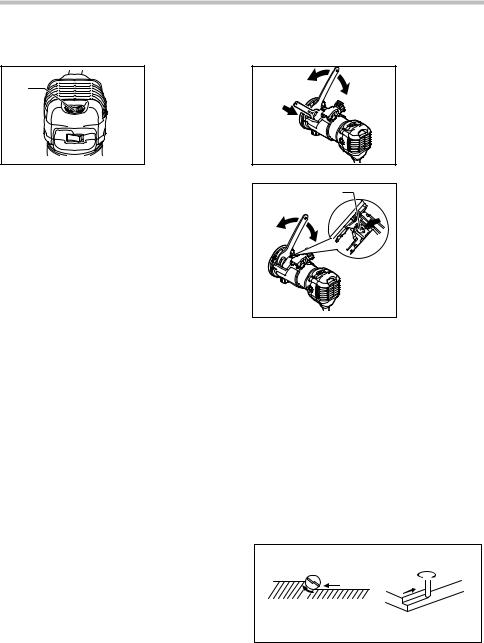
Speed adjusting dial |
|
Installing or removing trimmer bit |
|||
|
1. Speed adjusting |
1 |
|
1. Tighten |
|
1 |
dial |
|
2. |
Loosen |
|
|
|
2 |
3. |
Hold |
|
|
|
3 |
|||
|
|
|
|
||
|
|
|
|
|
|
011835
The tool speed can be changed by turning the speed adjusting dial to a given number setting from 1 to 6. Higher speed is obtained when the dial is turned in the direction of number 6. And lower speed is obtained when it is turned in the direction of number 1.
This allows the ideal speed to be selected for optimum material processing, i.e. the speed can be correctly adjusted to suit the material and bit diameter.
Refer to the table for the relationship between the number settings on the dial and the approximate tool speed.
Number |
min-1 |
1 |
10,000 |
2 |
12,000 |
3 |
17,000 |
4 |
22,000 |
5 |
27,000 |
6 |
30,000 |
011932
 CAUTION:
CAUTION:
•If the tool is operated continuously at low speeds for a long time, the motor will get overloaded, resulting in tool malfunction.
•The speed adjusting dial can be turned only as far as 6 and back to 1. Do not force it past 6 or 1, or the speed adjusting function may no longer work.
ASSEMBLY
 CAUTION:
CAUTION:
•Always be sure that the tool is switched off and unplugged before carrying out any work on the tool.
011837 |
3 |
1 |
2 |
011987 |
 CAUTION:
CAUTION:
1.Tighten
2.Loosen
3.Shaft lock
•Do not tighten the collet nut without inserting a bit, or the collet cone will break.
•Use only the wrenches provided with the tool. Insert the bit all the way into the collet cone and tighten the collet nut securely with the two wrenches or by pressing the shaft lock and using the provided wrench. To remove the bit, follow the installation procedure in reverse.
OPERATION
Set the tool base on the workpiece to be cut without the bit making any contact. Then turn the tool on and wait until the bit attains full speed. Move the tool forward over the workpiece surface, keeping the tool base flush and advancing smoothly until the cutting is complete.
When doing edge cutting, the workpiece surface should be on the left side of the bit in the feed direction.
|
|
2 |
1 |
4 |
4 |
2 |
|
|
|
|
|
|
3 |
|
1.Workpiece
2.Bit revolving direction
3.View from the top of the tool
4.Feed direction
001984
5
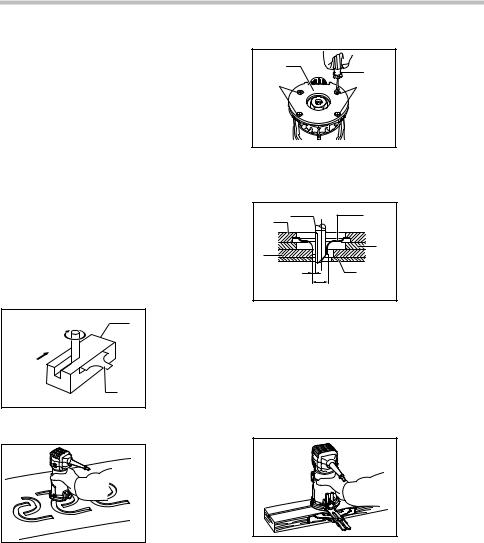
 CAUTION:
CAUTION:
•Since excessive cutting may cause overload of the motor or difficulty in controlling the tool, the depth of cut should not be more than 3 mm (1/8") at a pass when cutting grooves. When you wish to cut grooves more than 3 mm (1/8") deep, make several passes with progressively deeper bit settings.
NOTE:
•Moving the tool forward too fast may cause a poor quality of cut, or damage to the bit or motor. Moving the tool forward too slowly may burn and mar the cut. The proper feed rate will depend on the bit size, the kind of workpiece and depth of cut. Before beginning the cut on the actual workpiece, it is advisable to make a sample cut on a piece of scrap lumber. This will show exactly how the cut will look as well as enable you to check dimensions.
•When using the trimmer shoe, the straight guide or the trimmer guide, be sure to keep it on the right side in the feed direction. This will help to keep it flush with the side of the workpiece.
2 |
3 |
1. |
Feed direction |
|
2. |
Bit revolving |
|||
|
|
|||
|
|
|
direction |
|
|
|
3. Workpiece |
||
1 |
|
4. |
Straight guide |
|
|
4 |
|
|
|
001985
Templet guide (optional accessory)
011838
The templet guide provides a sleeve through which the bit passes, allowing use of the trimmer with templet patterns. Loosen the screws and remove the base protector. Place the templet guide on the base and replace the base protector. Then secure the base protector by tightening the screws.
|
|
1. |
Base protector |
|
1 |
3 |
2. |
Screws |
|
2 |
3. |
Screwdriver |
||
2 |
||||
|
|
011839
Secure the templet to the workpiece. Place the tool on the templet and move the tool with the templet guide sliding along the side of the templet.
|
1 |
|
6 |
|
1. |
Straight bit |
2 |
|
|
2. |
Base |
||
|
|
|
|
|||
|
|
|
|
|
3. |
Templet |
|
|
|
|
7 |
4. |
Distance (X) |
3 |
|
|
|
5. Workpiece |
||
|
|
|
|
|||
|
4 |
|
5 |
|
6. |
Templet guide |
|
|
|
|
10 |
||
|
|
10mm (3/8") |
|
|
7. |
Base protector |
|
|
|
|
|
|
|
011982 |
|
|
|
|
|
|
NOTE: |
|
|
|
|
|
|
•The workpiece will be cut a slightly different size from the templet. Allow for the distance (X) between the router bit and the outside of the templet guide. The distance (X) can be calculated
by using the following equation:
Distance (X) = (outside diameter of the templet guide - router bit diameter) / 2
Straight guide (optional accessory)
011840 |
The straight guide is effectively used for straight cuts when chamfering or grooving.
Attach the guide plate to the straight guide with the bolt and the wing nut.
6
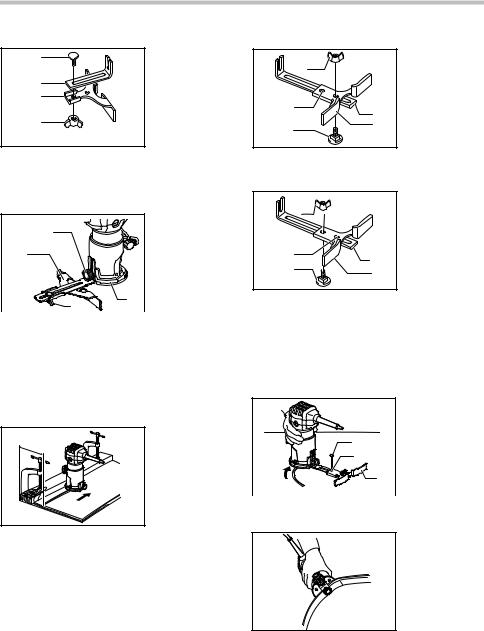
1 |
1. |
Bolt |
|
|
2. |
Guide plate |
|
2 |
3. |
Straight guide |
|
4. |
Wing nut |
||
3 |
|||
|
|
||
4 |
|
|
001990
Attach the straight guide with the clamp screw (A). Loosen the wing nut on the straight guide and adjust the distance between the bit and the straight guide. At the desired distance, tighten the wing nut securely.
|
|
1. |
Clamp screw (A) |
1 |
|
2. |
Straight guide |
|
|
3. Wing nut |
|
2 |
|
4. |
Base |
|
|
|
|
|
3 |
4 |
|
|
|
|
|
011841
When cutting, move the tool with the straight guide flush with the side of the workpiece.
If the distance (A) between the side of the workpiece and the cutting position is too wide for the straight guide, or if the side of the workpiece is not straight, the straight guide cannot be used. In this case, firmly clamp a straight board to the workpiece and use it as a guide against the trimmer base. Feed the tool in the direction of the arrow.
A
011842
Circular work
Circular work may be accomplished if you assemble the straight guide and guide plate as shown in the figures. Min. and max. radius of circles to be cut (distance between the center of circle and the center of bit) are as follows:
Min.: 70 mm (2-3/4") Max.: 221 mm (8-11/16")
For cutting circles between 70 mm (2-3/4") and 121 mm (4-3/4") in radius.
|
1. |
Wing nut |
1 |
2. |
Guide plate |
|
3. |
Straight guide |
|
4. |
Center hole |
4 |
5. |
Bolt |
2 |
|
|
|
|
|
5 |
3 |
|
|
|
001993
For cutting circles between 121 mm (4-3/4") and 221 mm (8-11/16") in radius.
|
|
1. |
Wing nut |
|
1 |
2. |
Guide plate |
|
3. |
Straight guide |
|
|
|
||
|
|
4. |
Center hole |
|
|
5. |
Bolt |
4 |
|
2 |
|
5 |
|
|
|
|
3 |
|
|
|
|
|
001994
NOTE:
•Circles between 172 mm (6-3/4") and 186 mm (7-5/16") in radius cannot be cut using this guide.
Align the center hole in the straight guide with the center of the circle to be cut. Drive a nail less than 6 mm (1/4") in diameter into the center hole to secure the straight guide. Pivot the tool around the nail in clockwise direction.
1. Nail
2. Center hole
3. Straight guide
1
2
3
011843
Trimmer guide (optional accessory)
011844
Trimming, curved cuts in veneers for furniture and the like can be done easily with the trimmer guide. The guide roller rides the curve and assures a fine cut.
Install the trimmer guide on the tool base with the clamp screw (A). Loosen the clamp screw (B) and adjust the
7
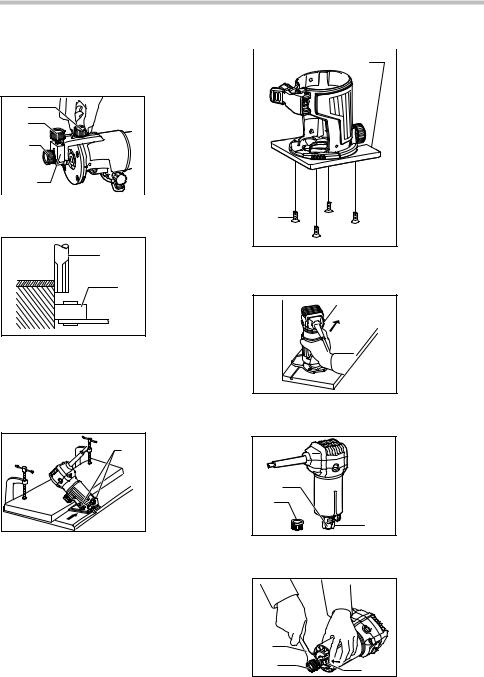
distance between the bit and the trimmer guide by turning the adjusting screw (1 mm (3/64") per turn). At the desired distance, tighten the clamp screw (B) to secure the trimmer guide in place.
1 |
1. Clamp screw (A) |
|
2. Adjusting screw |
||
|
||
2 |
3. Clamp screw (B) |
|
3 |
4. Trimmer guide |
|
|
4
011845
When cutting, move the tool with the guide roller riding the side of the workpiece.
1. Workpiece
22. Bit
3. Guide roller
3
1
001998
Tilt base (optional accessory)
Tilt base (optional accessory) is convenient for chamfering.
Place the tool onto the tilt base and close the locking lever at the desired protrusion of the bit. For desired angle, tighten the clamping screws on its sides.
1 |
1. Clamping |
screws |
|
011993 |
|
Firmly clamp a straight board to the workpiece and use it as a guide against the tilt base. Feed the tool in the direction of the arrow.
Base protector removed from the tilt base (optional accessory)
Mounting the base protector which has been removed from the tilt base on the trimmer base allows the change of the trimmer base from the round base to a square base.
For another application, remove the base protector from the tilt base by loosening and removing four screws.
1 |
1. |
Base protector |
2. |
Screw |
2
011994
And then mount the base protector on the trimmer base.
Offset base (optional accessory)
012085
(1)Offset base (optional accessory) is convenient for work in a tight area such as a corner.
1.Pulley
2.Collet nut
3.Collet cone
3
1
2
011858
Before installing the tool on the offset base, remove the collet nut and collet cone by loosening the collet nut.
|
1. Wrench |
|
2. Pulley |
|
3. Shaft lock |
1 |
|
2 |
3 |
|
|
011985 |
|
8
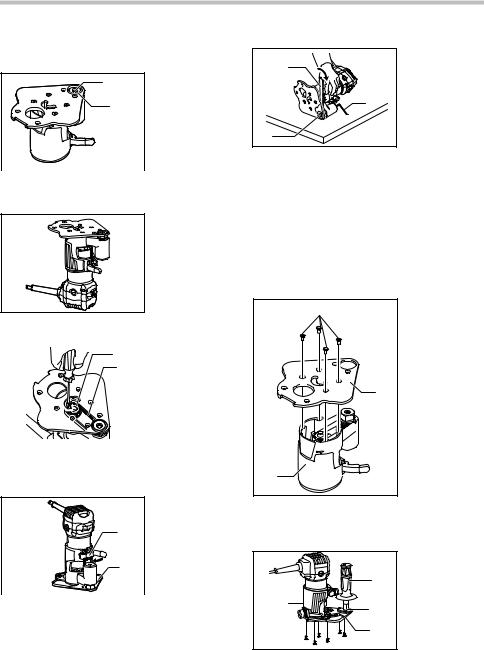
Install the pulley on the tool by pressing the shaft lock and firmly tightening the pulley with a wrench.
2 |
1. |
Collet nut |
|
2. |
Collet cone |
||
|
|||
|
1 |
|
011859
Place the collet cone and screw the collet nut on the offset base as shown in the figure.
011860
Mount the tool on the offset base
1 |
|
1. |
Pulley |
|
|
2. |
Belt |
||
|
|
2 |
||
|
|
|
|
|
|
|
|
|
|
|
|
|
|
|
|
|
|
|
|
011861
Put an end of the belt over the pulley using a screwdriver and make sure that its entire belt width fits over the pulley completely.
1. Locking lever
2. Offset base
1
2
011862
Secure it with a locking lever on the offset base.
|
1. Wrench |
|
1 |
2. |
Hex wrench |
|
3. |
Bit |
|
2 |
|
3 |
|
|
011992 |
|
|
To install the bit, fall the tool with the offset base on its side. Insert the hex wrench into the hole in the offset base. With the hex wrench held in that position, insert the bit into the collet cone on the shaft of the offset base from the opposite side and tighten the collet nut firmly with a wrench. To remove the bit at replacement, follow the installation procedure in reverse.
(2)Offset base (optional accessory) can also be used with a trimmer base and a grip attachment (optional accessory) for more stability.
1.Screws
12. Offset base plate
3. Upper section of the offset base
2
3
011934
Loosen the screws and remove the upper section from the offset base. Put aside the upper section of the offset base.
|
|
1. |
Bar type grip |
|
|
|
|
(optional accessory) |
|
|
1 |
2. |
Grip attachment |
|
|
|
|
(optional accessory) |
|
4 |
2 |
3. |
Offset base plate |
|
4. Trimmer base |
||||
|
||||
|
3 |
|
assembly (optional |
|
|
|
accessory) |
||
011935
Mount the trimmer base with four screws and the grip attachment (optional accessory) with two screws on the offset base plate.
9

Screw a bar type grip (optional accessory) onto the grip attachment.
1. Screw
1 2. Knob type grip
3. Offset base plate
2
3
011984
In another way of use, the knob type grip which is removed from a plunge base (optional accessory) can be installed on the grip attachment. To install the knob type grip, place it on the grip attachment and secure it with a screw.
011986 |
When using as a router only with a plunge base (optional accessory)
 CAUTION:
CAUTION:
•When using as a router, hold the tool firmly with both hands.
1. Plunge base
2. Grip
2
1
011855
To use the tool as a router, install the tool on a plunge base (optional accessory) by pressing it down fully. Either knob type grip or bar type grip (optional accessory) can be used according to your work.
1. Screw
2. Knob
1
2
011856
To use the bar type grip (optional accessory), loosen the screw and remove the knob type grip.
1. Bar type grip (optional
1 accessory)
011857
And then screw the bar type grip on the base.
Adjusting the depth of cut when using the plunge base (optional accessory)
|
1. Adjusting knob |
|
|
2. |
Lock lever |
|
3. |
Depth pointer |
|
4. |
Stopper pole |
1 |
|
setting nut |
|
5. Fast-feed button |
|
2 |
6. Stopper pole |
|
|
7. Stopper block |
|
3 |
8. Adjusting bolt |
|
|
|
|
4 |
|
|
5 |
|
|
6 |
|
|
7 |
8 |
|
011983 |
|
|
Place the tool on a flat surface. Loosen the lock lever and lower the tool body until the bit just touches the flat surface. Tighten the lock lever to lock the tool body.
Turn the stopper pole setting nut counterclockwise. Lower the stopper pole until it makes contact with the adjusting bolt. Align the depth pointer with the "0" graduation. The depth of cut is indicated on the scale by the depth pointer.
While pressing the fast-feed button, raise the stopper pole until the desired depth of cut is obtained. Minute depth adjustments can be obtained by turning the adjusting knob (1 mm per turn).
10
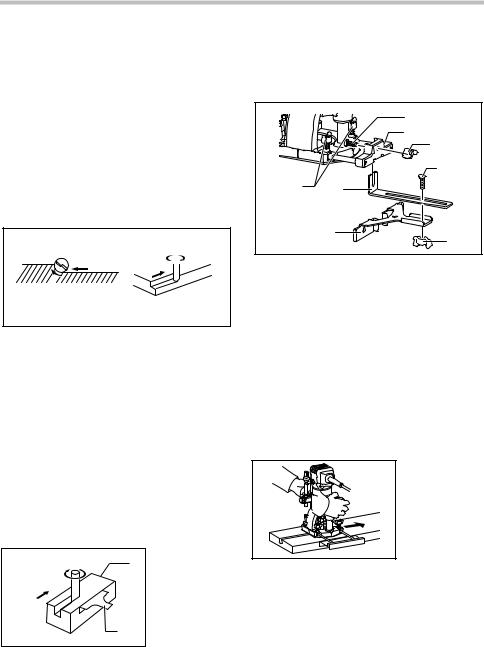
By turning the stopper pole setting nut clockwise, you can fasten the stopper pole firmly.
Now, your predetermined depth of cut can be obtained by loosening the lock lever and then lowering the tool body until the stopper pole makes contact with the adjusting hex bolt of the stopper block.
Always firmly hold the tool by both grip during operation. Set the tool base on the workpiece to be cut without the bit making any contact. Then turn the tool on and wait until the bit attains full speed. Lower the tool body and move the tool forward over the workpiece surface, keeping the tool base flush and advancing smoothly until the cutting is complete.
When doing edge cutting, the workpiece surface should be on the left side of the bit in the feed direction.
|
|
2 |
1 |
4 |
4 |
2 |
|
|
|
|
|
|
3 |
|
1.Workpiece
2.Bit revolving direction
3.View from the top of the tool
4.Feed direction
001984
NOTE:
•Moving the tool forward too fast may cause a poor quality of cut, or damage to the bit or motor. Moving the tool forward too slowly may burn and mar the cut. The proper feed rate will depend on the bit size, the kind of workpiece and depth of cut. Before beginning the cut on the actual workpiece, it is advisable to make a sample cut on a piece of scrap lumber. This will show exactly how the cut will look as well as enable you to check dimensions.
•When using the straight guide, be sure to install it on the right side in the feed direction. This will help to keep it flush with the side of the workpiece.
2 |
3 |
1. |
Feed direction |
|
2. |
Bit revolving |
|||
|
|
|||
|
|
|
direction |
|
|
|
3. Workpiece |
||
1 |
|
4. |
Straight guide |
|
|
4 |
|
|
|
001985
Straight guide when using as a router (needed to use with guide holder (optional accessory))
The straight guide is effectively used for straight cuts when chamfering or grooving.
1
2
3
4
8 6
7
5
1.Bolt
2.Guide holder
3.Wing nut
4.Bolt
5.Wing nut
6.Guide plate
7.Straight guide
8.Wing bolts
011988
Install the straight guide on the guide holder (optional accessory) with the wing nut.
Insert the guide holder into the holes in the plunge base and tighten the wing bolts. To adjust the distance between the bit and the straight guide, loosen the wing nut. At the desired distance, tighten the wing nut to secure the straight guide in place.
Straight guide (optional accessory)
011848 |
The straight guide is effectively used for straight cuts when chamfering or grooving.
11
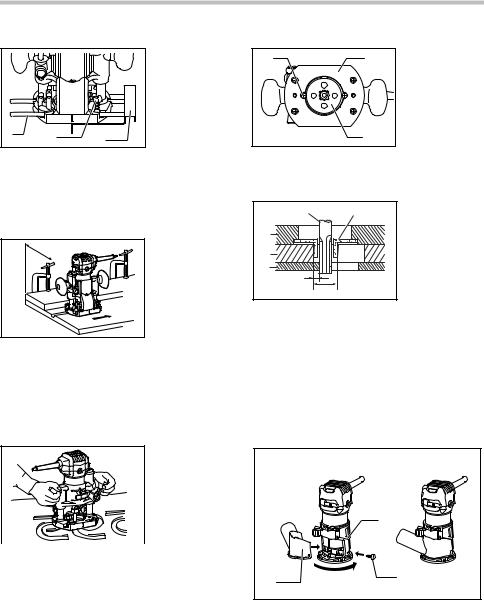
|
|
1. |
Guide bar |
|
|
2. |
Wing bolt |
|
|
3. Straight guide |
|
1 |
2 |
3 |
|
|
|
||
011849 |
|
|
|
To install the straight guide, insert the guide bars into the holes in the plunge base. Adjust the distance between the bit and the straight guide. At the desired distance, tighten the wing bolts to secure the straight guide in place.
When cutting, move the tool with the straight guide flush with the side of the workpiece.
A |
011850 |
If the distance (A) between the side of the workpiece and the cutting position is too wide for the straight guide, or if the side of the workpiece is not straight, the straight guide cannot be used. In this case, firmly clamp a straight board to the workpiece and use it as a guide against the router base. Feed the tool in the direction of the arrow.
Templet guide (optional accessory)
011851
The templet guide provides a sleeve through which the bit passes, allowing use of the tool with templet patterns. To install the templet guide, loosen the screws on the tool base, insert the templet guide and then tighten the screws.
1 |
2 |
1. |
Screw |
|
2. |
Base |
|||
|
|
|||
|
|
3. Templet |
||
3
011852
Secure the templet to the workpiece. Place the tool on the templet and move the tool with the templet guide sliding along the side of the templet.
1 |
7 |
1. |
Bit |
|
|
2. |
Base |
2 |
|
3. |
Templet |
|
4. |
Workpiece |
|
|
|
||
3 |
|
5. |
Distance (X) |
|
6. |
Outside |
|
4 |
|
||
|
|
diameter of the |
|
5 |
|
|
|
|
|
templet guide |
|
|
6 |
|
|
|
7. |
Templet guide |
|
003695 |
|
|
|
NOTE: |
|
|
|
•The workpiece will be cut a slightly different size from the templet. Allow for the distance (X) between the bit and the outside of the templet guide. The distance (X) can be calculated by using the following equation:
Distance (X) = (outside diameter of the templet guide - bit diameter) / 2
Dust nozzle sets (optional accessory)
For the trimmer base
|
3 |
1 |
2 |
|
1.Dust nozzle
2.Thumb screw
3.Trimmer base
011989
12
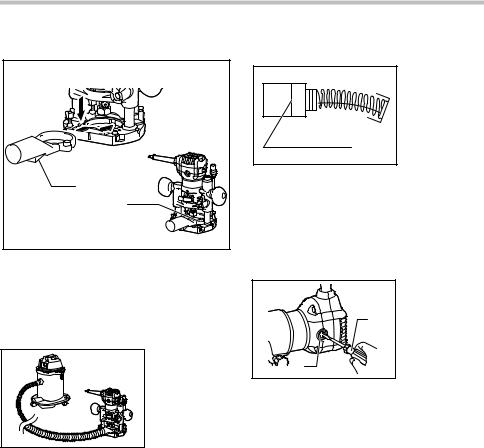
For the plunge base
1 |
2 |
1.Dust nozzle
2.Thumb screw
011853
Use the dust nozzle for dust extraction. Install the dust nozzle on the tool base using the thumb screw so that protrusion on the dust nozzle fit to the notch in the tool base.
Then connect a vacuum cleaner to the dust nozzle.
011854
MAINTENANCE
 CAUTION:
CAUTION:
•Always be sure that the tool is switched off and unplugged before attempting to perform inspection or maintenance.
•Never use gasoline, benzine, thinner, alcohol or the like. Discoloration, deformation or cracks may result.
Replacing carbon brushes
1. Limit mark
1
001145
Remove and check the carbon brushes regularly. Replace when they wear down to the limit mark. Keep the carbon brushes clean and free to slip in the holders. Both carbon brushes should be replaced at the same time. Use only identical carbon brushes.
Use a screwdriver to remove the brush holder caps. Take out the worn carbon brushes, insert the new ones and secure the brush holder caps.
1. Screwdriver
2. Brush holder cap
1
2
011846
To maintain product SAFETY and RELIABILITY, repairs, any other maintenance or adjustment should be performed by Makita Authorized or Factory Service Centers, always using Makita replacement parts.
OPTIONAL ACCESSORIES
 CAUTION:
CAUTION:
•These accessories or attachments are recommended for use with your Makita tool specified in this manual. The use of any other accessories or attachments might present a risk of injury to persons. Only use accessory or
attachment for its stated purpose.
If you need any assistance for more details regarding these accessories, ask your local Makita Service Center.
•Straight & groove forming bits
•Edge forming bits
•Laminate trimming bits
•Straight guide assembly
•Trimmer guide assembly
•Trimmer base assembly
•Tilt base assembly
•Plunge base assembly
•Offset base assembly
13

•Templet guide
•Collet cone 1/4"
•Collet cone 3/8"
•Wrench 13
•Wrench 22
•Dust nozzle set
NOTE:
•Some items in the list may be included in the tool package as standard accessories. They may differ from country to country.
MAKITA LIMITED ONE YEAR WARRANTY
Warranty Policy
Every Makita tool is thoroughly inspected and tested before leaving the factory. It is warranted to be free of defects from workmanship and materials for the period of ONE YEAR from the date of original purchase. Should any trouble develop during this one year period, return the COMPLETE tool, freight prepaid, to one of Makita’s Factory or Authorized Service Centers. If inspection shows the trouble is caused by defective workmanship or material, Makita will repair (or at our option, replace) without charge.
This Warranty does not apply where:
repairs have been made or attempted by others:
repairs are required because of normal wear and tear:
the tool has been abused, misused or improperly maintained:
alterations have been made to the tool.
IN NO EVENT SHALL MAKITA BE LIABLE FOR ANY INDIRECT, INCIDENTAL OR CONSEQUENTIAL DAMAGES FROM THE SALE OR USE OF THE PRODUCT. THIS DISCLAIMER APPLIES BOTH DURING AND AFTER THE TERM OF THIS WARRANTY.
MAKITA DISCLAIMS LIABILITY FOR ANY IMPLIED WARRANTIES, INCLUDING IMPLIED WARRANTIES OF "MERCHANTABILITY" AND "FITNESS FOR A SPECIFIC PURPOSE," AFTER THE ONE YEAR TERM OF THIS WARRANTY.
This Warranty gives you specific legal rights, and you may also have other rights which vary from state to state. Some states do not allow the exclusion or limitation of incidental or consequential damages, so the above limitation or exclusion may not apply to you. Some states do not allow limitation on how long an implied warranty lasts, so the above limitation may not apply to you.
EN0006-1
14

FRANÇAIS (Mode d’emploi original)
SPÉCIFICATIONS
Modèle |
RT0700C / RT0701C |
Capacité du mandrin à bague |
1/4", 3/8" |
Vitesse à vide (T/MIN) |
10 000 - 30 000 /min |
Longueur totale |
200 mm (7-7/8") |
Poids net |
1,8 (3,9 lbs) |
•Étant donné l'évolution constante de notre programme de recherche et de développement, les spécifications contenues dans ce manuel sont sujettes à modification sans préavis.
•Les spécifications peuvent varier suivant les pays.
• Poids conforme à la procédure EPTA du 01/2003
GEA008-2
Consignes de sécurité générales pour outils électriques
 MISE EN GARDE Veuillez lire toutes les mises en garde de sécurité et toutes les instructions. L'ignorance des mises en garde et des instructions comporte un risque de choc électrique, d'incendie et/ou de blessure grave.
MISE EN GARDE Veuillez lire toutes les mises en garde de sécurité et toutes les instructions. L'ignorance des mises en garde et des instructions comporte un risque de choc électrique, d'incendie et/ou de blessure grave.
Conservez toutes les mises en garde et instructions pour référence future.
Le terme outil électrique qui figure dans les avertissements fait référence à un outil électrique branché sur une prise de courant (par un cordon d'alimentation) ou alimenté par batterie (sans fil).
Sécurité de la zone de travail
1.Maintenez la zone de travail propre et bien éclairée. Les zones de travail encombrées ou sombres ouvrent grande la porte aux accidents.
2.N'utilisez pas les outils électriques dans les atmosphères explosives, par exemple en présence de liquides, gaz ou poussières inflammables. Les outils électriques produisent des étincelles au contact desquelles la poussière ou les vapeurs peuvent s'enflammer.
3.Assurez-vous qu'aucun enfant ou curieux ne s'approche pendant que vous utilisez un outil
électrique. Vous risquez de perdre la maîtrise de l'outil si votre attention est détournée.
Sécurité en matière d'électricité
4.Les fiches d'outil électrique sont conçues pour s'adapter parfaitement aux prises de courant. Ne modifiez jamais la fiche de quelque façon que ce soit. N'utilisez aucun adaptateur de fiche sur les outils électriques avec mise à la terre. En ne modifiant pas les fiches et en les insérant dans des prises de courant pour lesquelles elles ont été conçues vous réduirez les risques de choc électrique.
5.Évitez tout contact corporel avec les surfaces mises à la terre, telles que les tuyaux, radiateurs, cuisinières et réfrigérateurs. Le risque de choc électrique est plus élevé si votre corps se trouve mis à la terre.
6.N'exposez pas les outils électriques à la pluie ou à l'eau. La présence d'eau dans un outil électrique augmente le risque de choc électrique.
7.Ne maltraitez pas le cordon. N'utilisez jamais le cordon pour transporter, tirer ou débrancher l'outil électrique. Maintenez le cordon à l'écart des sources de chaleur, de l'huile, des objets à bords tranchants et des pièces en mouvement. Le risque de choc électrique est plus élevé lorsque les cordons sont endommagés ou enchevêtrés.
8.Lorsque vous utilisez un outil électrique à l'extérieur, utilisez un cordon prolongateur prévu à cette fin. Les risques de choc électrique sont moindres lorsqu'un cordon conçu pour l'extérieur est utilisé.
9.Si vous devez utiliser un outil électrique dans un endroit humide, utilisez une source d'alimentation protégée par un disjoncteur de
fuite à la terre. L'utilisation d'un disjoncteur de fuite à la terre réduit le risque de choc électrique.
Sécurité personnelle
10.Restez alerte, attentif à vos mouvements et faites preuve de bon sens lorsque vous utilisez un outil électrique. Évitez d'utiliser un outil électrique si vous êtes fatigué ou si vous avez pris une drogue, de l'alcool ou un médicament.
Un moment d'inattention pendant l'utilisation d'un outil électrique peut entraîner une grave blessure.
11.Portez des dispositifs de protection personnelle. Portez toujours un protecteur pour la vue. Les risques de blessure seront moins élevés si vous utilisez des dispositifs de protection tels qu'un masque antipoussières, des chaussures à semelle antidérapante, une coiffure résistante ou une protection d'oreilles.
15
